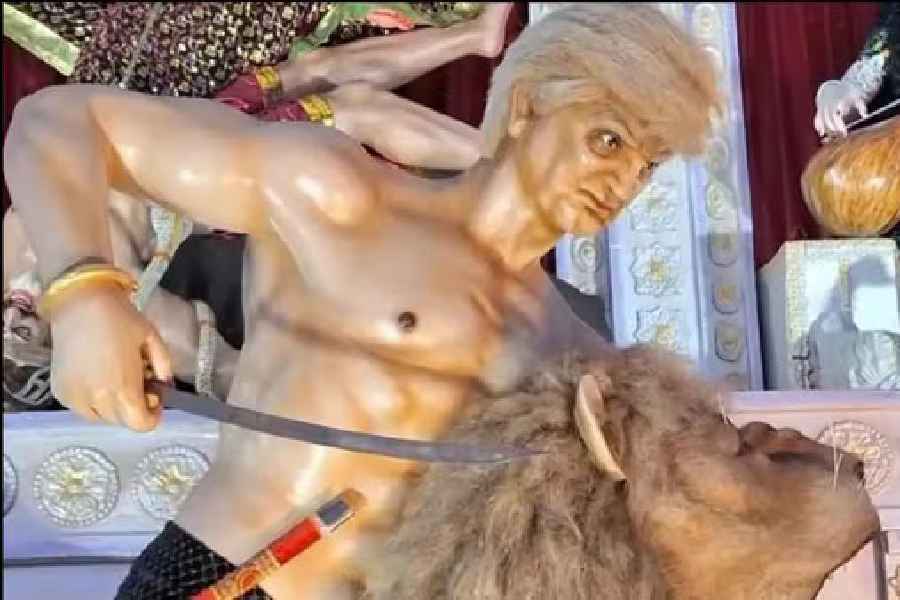Too close
Sir — Politics and Durga Puja have become increasingly intertwined, with the festival gradually evolving into a canvas for political expression and social commentary. A Durga Puja pandal in West Bengal this year reimagined the president of the United States of America as Mahisasur. The organisers said that their artistic choice was inspired by the collective betrayal that Indians experienced from Donald Trump’s imposition of exorbitant retaliatory tariffs and the implementation of a stringent visa regime. One is curious, though, about how the mighty Trump would feel on being vanquished by the goddess in real life. Given Trump’s refusal to face defeat, he could easily be expected to bellow, “I never lost to Durga. The battle was rigged.”
Sarthak Maitra,
Calcutta
Three jewels
Sir — Ramachandra Guha’s article, “Friends and icons” (Oct 4), arrived as a cheerful, optimistic ray of light, portraying the best of Bengaluru and the idea of India which is diverse, heterogeneous and all-embracing. At a time when disproportionate focus is awarded to film stars and cricketers, Guha chose to highlight three comparatively unknown gems of that city, Biren Das, Chiranjiv Singh and Arundhati Nag, who have enriched Bengaluru through their contributions.
These three jewels not only literally translocated themselves to Karnataka’s capital but also made it their home. They have harboured huge respect for the Kannada culture and language. This must serve as a lesson for those advocating protectionism and closed-door policies.
Kajal Chatterjee,
Calcutta
Sir — The stories of Biren Das, Chiranjiv Singh and Arundhati Nag, who became celebrated Bengalurians despite not hailing from the city, represent the most admirable attributes of the city. The trio embodies the spirit of diversity and humanism that are cornerstones of Indian pluralism.
Sukhendu Bhattacharjee,
Hooghly
Political tool
Sir — The Central Board of Film Certification seems to have relinquished its role as a certifying authority and turned into an instrument of political control (“Moral board”, Oct 3). It trims and tones down narratives that question authority or challenge entrenched power structures.
The most distressing aspect is the absence of any neutral mechanism for redressal. With the dissolution of the appellate tribunal, film-makers are left with no option but to submit to arbitrary diktats or see their films stalled, delayed, or released in mutilated form. This clearly shows that censorship is less about public sensibility and more about safeguarding political vote banks. The CBFC must return to its original mandate which is to certify, not censor.
Sourav Ash,
Calcutta
Sir — The CBFC’s role is to certify; yet it frequently orders cuts or modifications, effectively functioning as a censor board. Film-makers face challenges in bringing their creative vision to the public. The editorial, “Moral board”, rightly highlights the institutional decay of the CBFC. The body has been reduced to a one-man show. This is a disservice to cinema.
The point is amplified by another grave challenge: the growing power of the heckler’s veto. Even after navigating the hurdles of the CBFC, film-makers often face boycott calls and protests. The controversy during the release of Padmaavat is a case in point. When both State-appointed censors and mobs suppress creativity, democracy suffers.
S.S. Paul,
Nadia
Sir — Rather than functioning as a neutral certifying body, the CBFC has been acting as a censor and moral police. Recent reports highlight concerns about arbitrary cuts and political interference. The makers of Homebound were asked to remove all caste references. Phule was censored over caste references and released only after making at least a dozen modifications ordered by the CBFC.
Several film-makers accuse the CBFC of functioning as a vetting committee that adheres to the whims of the ideology of the ruling party. The absence of an appellate tribunal and the internal irregularities leave film-makers with limited options, fostering a culture of self-censorship.
Khokan Das,
Calcutta
True pioneer
Sir — Jane Goodall was a famous conservationists who revolutionised the study of one of the great apes in the 20th century and opened the doors for more women to venture into a male-dominated field (“Ahead of her time”, Oct 5). She was granted a rare opportunity to pursue a PhD at Cambridge without a prior bachelor’s degree for her groundbreaking work.
Goodall was the first scientist to explain that chimpanzee mothers are capable of giving birth only once every 4.5-6 years. She showed that chimpanzees have emotions, personalities and complex social lives. The world has lost a legend who changed the waywe see animals.
Bal Govind,
Noida
Sir — The Telegraph has paid rich tribute to Jane Goodall, the renowned
conservationist, who passed away on October 1, at the age of 91, in the editorial “Ahead of her time”. The editorial brilliantly argued that Goodall’s life stands
as a counterpoint to the same arrogance that once denied animals their intelligence, as it now drives the exploitation of the Earth. Her pragmatic hope that small acts of care can make a change must be used to prevent the degradation of the environment.
Jahar Saha,
Calcutta
Sir — The interviews given by Jane Goodall need to be archived for posterity. She led a challenging life in Africa owing to her work which must be celebrated.
Bikram Banerjea,
Mumbai

